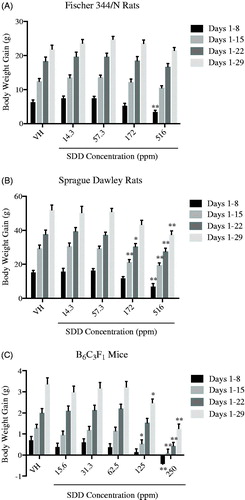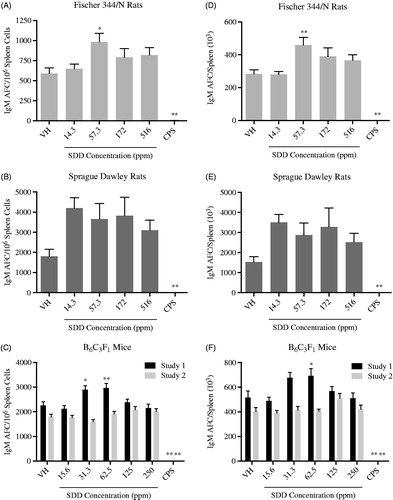Figures & data
Table 1. Exposure endpoints.
Figure 1. Mean body weight gain in female Fischer 344/N and Sprague Dawley rats and B6C3F1 mice following exposure to SDD in drinking water for 28 days. Mean body weight gain (g) reported for Days 1–8, 1–15, 1–22, and 1–29 (study termination). Mean body weight gain of (A) Fischer 344/N rats, (B) Sprague Dawley rats, and (C) B6C3F1 mice. Data are expressed as mean ± SEM. *p ≤ 0.05, **p ≤ 0.01 for exposed groups compared to vehicle contol. N = 32 for F344/N rats. N = 40 for SD rats and B6C3F1 mice. VH: vehicle control.

Table 2. MCV and MCH levels in the blood of Fischer 344/N and Sprague Dawley rats.
Table 3. MCV and MCH levels in the blood of B6C3F1 mice.
Table 4. Spleen lymphocyte sub-populations in Fischer 344/N and Sprague Dawley rats.
Table 5. Spleen lymphocyte sub-populations in B6C3F1 mice.
Figure 2. IgM antibody-forming cell (AFC) response to sheep red blood cells (SRBC) in female Fischer 344/N and Sprague Dawley rats and B6C3F1 mice following exposure to SDD in drinking water for 28 days. The AFC response to SRBC was evaluated in splenocyte suspensions prepared from previously immunized animals and reported as either specific activity (AFC/106 spleen cells) or total activity (AFC/spleen). Specific activity (AFC/106 spleen cells) in (A) F344/N rats, (B) SD rats, and (C) B6C3F1 mice. Total activity (AFC/spleen) in (D) F344/N rats, (E) SD rats, and (F) B6C3F1 mice. Data are expressed as mean ± SEM. *p ≤ 0.05, **p ≤ 0.01 for exposed groups compared to vehicle contol. N = 7 (VH, 14.3 and 172 ppm) or 8 (57.3 and 516 ppm) for F344/N rats. N = 10 for SD rats. N = 8 for B6C3F1 mice. VH: vehicle control; CPS: cyclophosphamide positive control (50 mg/kg).

Table 6. Serum IgM antibody titers to SRBC in Sprague Dawley rats and B6C3F1 mice.
